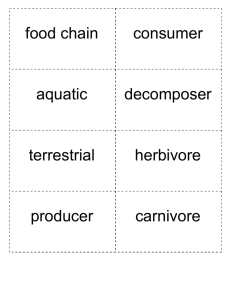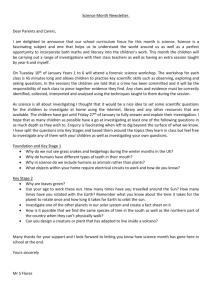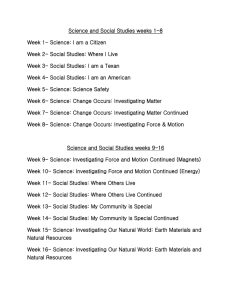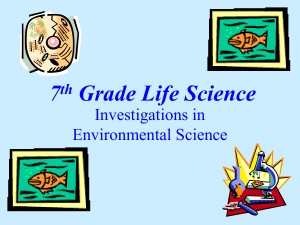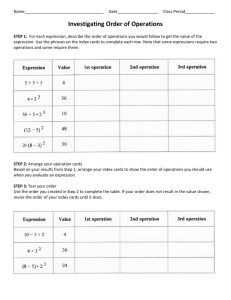Third Grade Science Pacing Guide
advertisement
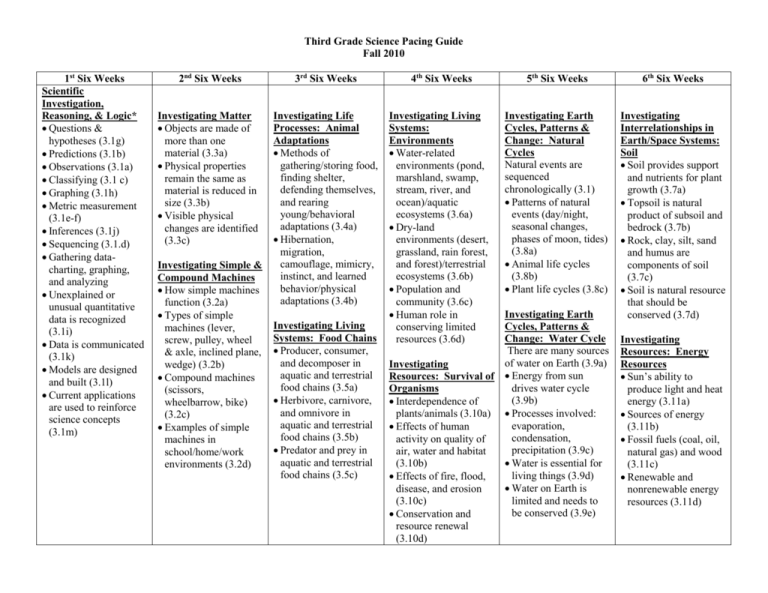
Third Grade Science Pacing Guide Fall 2010 1st Six Weeks Scientific Investigation, Reasoning, & Logic* Questions & hypotheses (3.1g) Predictions (3.1b) Observations (3.1a) Classifying (3.1 c) Graphing (3.1h) Metric measurement (3.1e-f) Inferences (3.1j) Sequencing (3.1.d) Gathering datacharting, graphing, and analyzing Unexplained or unusual quantitative data is recognized (3.1i) Data is communicated (3.1k) Models are designed and built (3.1l) Current applications are used to reinforce science concepts (3.1m) 2nd Six Weeks 3rd Six Weeks 4th Six Weeks 5th Six Weeks 6th Six Weeks Investigating Matter Objects are made of more than one material (3.3a) Physical properties remain the same as material is reduced in size (3.3b) Visible physical changes are identified (3.3c) Investigating Life Processes: Animal Adaptations Methods of gathering/storing food, finding shelter, defending themselves, and rearing young/behavioral adaptations (3.4a) Hibernation, migration, camouflage, mimicry, instinct, and learned behavior/physical adaptations (3.4b) Investigating Living Systems: Environments Water-related environments (pond, marshland, swamp, stream, river, and ocean)/aquatic ecosystems (3.6a) Dry-land environments (desert, grassland, rain forest, and forest)/terrestrial ecosystems (3.6b) Population and community (3.6c) Human role in conserving limited resources (3.6d) Investigating Earth Cycles, Patterns & Change: Natural Cycles Natural events are sequenced chronologically (3.1) Patterns of natural events (day/night, seasonal changes, phases of moon, tides) (3.8a) Animal life cycles (3.8b) Plant life cycles (3.8c) Investigating Interrelationships in Earth/Space Systems: Soil Soil provides support and nutrients for plant growth (3.7a) Topsoil is natural product of subsoil and bedrock (3.7b) Rock, clay, silt, sand and humus are components of soil (3.7c) Soil is natural resource that should be conserved (3.7d) Investigating Simple & Compound Machines How simple machines function (3.2a) Types of simple machines (lever, screw, pulley, wheel & axle, inclined plane, wedge) (3.2b) Compound machines (scissors, wheelbarrow, bike) (3.2c) Examples of simple machines in school/home/work environments (3.2d) Investigating Living Systems: Food Chains Producer, consumer, and decomposer in aquatic and terrestrial food chains (3.5a) Herbivore, carnivore, and omnivore in aquatic and terrestrial food chains (3.5b) Predator and prey in aquatic and terrestrial food chains (3.5c) Investigating Earth Cycles, Patterns & Change: Water Cycle There are many sources of water on Earth (3.9a) Investigating Resources: Survival of Energy from sun drives water cycle Organisms (3.9b) Interdependence of plants/animals (3.10a) Processes involved: evaporation, Effects of human condensation, activity on quality of precipitation (3.9c) air, water and habitat Water is essential for (3.10b) living things (3.9d) Effects of fire, flood, Water on Earth is disease, and erosion (3.10c) limited and needs to be conserved (3.9e) Conservation and resource renewal (3.10d) Investigating Resources: Energy Resources Sun’s ability to produce light and heat energy (3.11a) Sources of energy (3.11b) Fossil fuels (coal, oil, natural gas) and wood (3.11c) Renewable and nonrenewable energy resources (3.11d) Third Grade Science Vocabulary Fall 2007 1st Six Weeks Hypothesis Predict Observe Classify Sequence Graph Line plot Data Volume Length Mass Temperature Time Infer 2nd Six Weeks Matter Physical property Dissolve Mixture Solution Solid Liquid Gas Molecules Atoms Simple machine Wheel and axle Wedge Screw Pulley Lever Inclined plane Compound machine 3rd Six Weeks Habitat Adaptation Defense Protection Mimicry Camouflage Migration Hibernation Producer Consumer Food chain Sequence Predator Prey Herbivore Omnivore Carnivore 4th Six Weeks Population Community Resources Environment Water-related environment Lake River Marsh Wetlands Swamp Stream Pond Ocean Dry-land environment Forest Desert Grassland Rainforest Riparian buffer Erosion Pollution Runoff Conservation Stewardship Dependent 5th Six Weeks Pattern Cycle Relationship Tide Phases Rotate Revolve Axis Orbit Clockwise Counter-clockwise Egg Larva Pupa Chrysalis Evaporation Condensation Precipitation Water cycle Reservoir Conservation Energy Limited resource Pollution Watershed 6th Six Weeks Minerals Rock Rock fragments Sand Clay Silt Humus Nutrients Topsoil Bedrock Subsoil Topsoil Organic material Inorganic material Erode Decay Weathering Drainage Soil conservation Energy source Solar energy Fossil fuel Coal Oil Natural gas Renewable resource Nonrenewable Resource Naturally occurring

